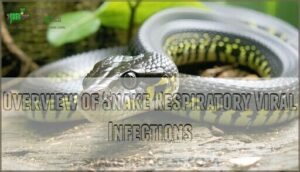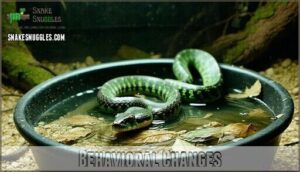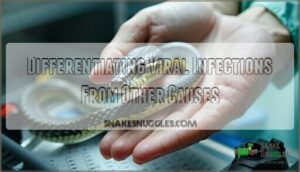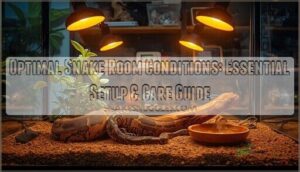This site is supported by our readers. We may earn a commission, at no cost to you, if you purchase through links.

Start by optimizing your snake’s environment—bump up the temperature to 85-88°F and maintain humidity around 60-70%. This helps their immune system fight back.
You can’t treat the virus directly, but secondary bacterial infections often tag along, so your vet might prescribe antibiotics like enrofloxacin.
Provide gentle supportive care including proper hydration and stress reduction. Think of it as nursing your scaly friend back to health rather than zapping the virus itself.
The real game-changer lies in understanding which specific treatments actually work.
Table Of Contents
- Key Takeaways
- How to Treat Snake Viral Respiratory Infection?
- Overview of Snake Respiratory Viral Infections
- Symptoms and Clinical Presentation
- Diagnostic Procedures for Viral Infections
- Differentiating Viral Infections From Other Causes
- Antibiotics and Antiviral Medications
- Supportive Care and Nursing Strategies
- Environmental Management and Husbandry
- Preventive Measures for Viral Infections
- Frequently Asked Questions (FAQs)
- How to fix respiratory infection in snakes?
- What is the best treatment for viral respiratory infections?
- What is the medicine for respiratory infection in reptiles?
- How do I know if my snake has an upper respiratory infection?
- What antibiotics are used for snake respiratory infections?
- How do you get rid of a respiratory viral infection?
- What does a respiratory infection look like on a snake?
- How long does it take for symptoms to appear?
- Are certain snake species more susceptible to viral infections?
- Can viral respiratory infections in snakes spread to humans?
- Conclusion
Key Takeaways
- Focus on supportive care instead of direct viral treatment – You can’t cure the virus itself, so maintain optimal temperatures (85-88°F) and humidity (60-70%) to boost your snake’s immune system and help it fight the infection naturally.
- Address secondary bacterial infections with veterinary help – You’ll likely need antibiotics, such as enrofloxacin, from a reptile vet, since bacterial complications often accompany viral infections and can be life-threatening if left untreated.
- Maintain strict environmental controls and quarantine protocols – You must isolate infected snakes for at least 30 days, ensure proper ventilation, and practice rigorous hygiene to prevent spreading the virus to other reptiles.
- Monitor closely and provide intensive nursing care – You’ll need to watch for breathing difficulties, provide hydration support, reduce stress through gentle handling, and be prepared for a recovery period of 10-14 days with consistent veterinary monitoring.
How to Treat Snake Viral Respiratory Infection?
Treating your snake’s viral respiratory infection requires stepping up your care game with professional veterinary guidance.
Your reptile vet will diagnose the specific viral snake infection and may prescribe antiviral medications alongside antibiotics to prevent secondary bacterial complications.
Your vet’s diagnosis determines the precise antiviral treatment plan for your snake’s recovery.
You’ll need to provide intensive supportive care including fluid therapy, nutritional support, and environmental optimization.
Maintain proper humidity levels and quarantine your snake to prevent viral coinfections with other reptiles.
While emerging viruses and antiviral resistance present challenges, combining traditional snake respiratory infection treatment with holistic approaches offers the best recovery outcomes for your scaly companion.
Overview of Snake Respiratory Viral Infections
Three key factors make viral etiology particularly challenging in snake respiratory infections.
Transmission pathways include direct contact, contaminated surfaces, and airborne droplets, making prevention essential for your snake’s health.
You’ll notice that viral snake infection often triggers a compromised immune response, leaving your pet vulnerable to secondary bacterial infections.
Coinfections frequently complicate diagnosis and treatment, as multiple pathogens attack simultaneously.
Emerging viruses continue to pose new threats to captive snakes, requiring ongoing vigilance from owners.
Unlike bacterial snake respiratory infections, viral cases don’t respond to antibiotics alone.
Snake respiratory infection symptoms from viral causes often mirror bacterial infections, making professional diagnosis essential.
Early recognition of snake respiratory infection treatment needs can prevent serious complications.
Understanding reptile viral infection basics helps you provide better care and recognize when veterinary intervention becomes necessary for your snake’s recovery.
Proper husbandry includes maintaining suitable temperature levels to help prevent such infections.
Symptoms and Clinical Presentation
Recognizing viral respiratory infections in your snake requires careful observation of specific breathing patterns and behavioral shifts.
You’ll notice distinctive symptoms that differ from bacterial infections and require immediate attention to prevent serious complications.
Respiratory Signs
Watch for telltale breathing sounds like wheezing, clicking, or gurgling that signal airway obstruction in your snake.
Those subtle breathing sounds are your snake’s distress signals—don’t ignore them.
During mouth examination, you’ll spot excess mucus presence around the oral cavity and nasal discharge.
These snake respiratory symptoms often accompany appetite changes and lethargy, creating a clear picture of snake viral respiratory infection requiring immediate attention.
Behavioral Changes
Beyond the obvious respiratory symptoms, you’ll spot telltale behavioral changes that signal trouble. Your snake’s normal routine gets completely disrupted when viral infections take hold.
Here are four key behavioral shifts to monitor:
- Lethargy Signs – Your snake becomes unusually sluggish and stops exploring its enclosure
- Hiding Behavior – Excessive retreat to hide boxes, avoiding normal basking spots
- Appetite Changes – Complete food refusal or decreased appetite lasting several feeding cycles
- Activity Reduction – Minimal movement even during typical active periods
These snake respiratory infection symptoms often appear alongside physical signs, making proper veterinary diagnosis essential for effective treatment.
Diagnostic Procedures for Viral Infections
When you suspect your snake has a viral respiratory infection, you’ll need proper diagnostic procedures to confirm the diagnosis and rule out other causes.
Your veterinarian will start with a thorough physical examination and may recommend specific laboratory tests to identify the pathogen affecting your snake’s respiratory system.
Physical Examination
Your physical examination starts with oral examination – check for bubbles, excess mucus, or inflamed tissues inside the mouth.
Perform skin assessment and palpation techniques around the throat area, feeling for swelling or abnormal masses.
Auscultation findings help detect wheezing or clicking sounds.
Consider using specialized tools during snake mouth inspections.
Evaluate hydration status by checking skin elasticity and examining overall body condition for snake respiratory infection diagnosis.
Laboratory Tests
Your vet will use specific laboratory tests to confirm viral respiratory infection diagnosis and determine the exact pathogen involved.
Sample collection from your snake’s respiratory tract enables PCR testing for viral identification, while cytology and lung washes provide detailed pathogen analysis.
Modern labs now emphasize high throughput methods for faster results.
- PCR testing detects viral genetic material with high test accuracy
- Respiratory pathogen testing through tracheal swabs and lung washes
- Cytology analysis examines cellular changes from infection
- Diagnostic advancements include molecular techniques for precise result interpretation
Differentiating Viral Infections From Other Causes
You’ll need to identify whether your snake’s respiratory infection is viral or bacterial since the treatment approaches differ substantially.
Viral infections often present with similar symptoms but require supportive care rather than antibiotics, making accurate diagnosis essential for your snake’s recovery.
Unique Viral Infection Symptoms
Subtle Indicators of viral respiratory conditions reveal themselves through clear mucoid nasal discharge and excessive salivation—hallmark signs of nidovirusserpentovirus infection.
Early Detection becomes essential when you spot snake viral nasal infection symptoms like stomatitis accompanying respiratory distress.
Specific Viruses such as paramyxovirus and inclusion body virus create distinct clinical presentations, with neurological symptoms setting them apart from bacterial causes.
A key preventative measure is to maintain optimal temperature ranges for your snake.
Symptom Progression typically affects multiple snakes simultaneously, creating Diagnostic Challenges that require careful observation.
Diagnostic Testing Methods
When you suspect your snake has a viral respiratory infection, accurate diagnostic testing becomes your roadmap to proper treatment.
Veterinarians use several proven methods to confirm viral pathogens and rule out bacterial causes:
- Sample Collection from nasal discharge or oral swabs for laboratory analysis
- PCR Testing to detect specific viral genetic material with high accuracy
- Viral Isolation through specialized cultures that identify active pathogens
- Antibody Detection via serological tests showing immune system response
These diagnostic tests for snake respiratory infection provide definitive answers.
Histopathology examines tissue samples under microscopy, while cultures distinguish viral from bacterial infections.
You can find products for snake virus detection online.
PCR testing offers rapid, precise results that guide your veterinarian’s treatment decisions effectively.
Eliminating Non-Viral Causes
Bacterial infections often produce thick, yellow discharge, while fungal infections create white, cottage cheese-like material.
Parasitic infections show visible lungworms or mites on examination. Effective snake mite control is essential to rule out parasitic causes.
Husbandry issues like temperature drops below 75°F trigger symptoms that mimic viral snake respiratory infection. Environmental factors including poor ventilation distinguish bacterial respiratory diseases from viral causes through targeted testing.
Antibiotics and Antiviral Medications
Once you’ve identified a viral respiratory infection in your snake, treatment becomes a delicate balancing act between fighting the virus and preventing secondary complications.
Antiviral medications like acyclovir and remdesivir show promising antiviral efficacy against specific viral strains, though they’re less commonly used than in human medicine.
Your reptile vet will likely prescribe antibiotics such as enrofloxacin (20-50 mg/kg) or ceftazidime to combat secondary bacterial infections that often accompany viral snake respiratory diseases.
Proper medication dosage is critical—too little won’t help, too much can cause serious side effects including kidney damage.
Treatment duration typically spans 10-14 days, but your snake vet care professional will monitor progress closely.
Remember, antibiotics won’t cure the virus itself, but they’ll prevent antibiotic resistance when used appropriately to stop bacterial opportunists from making your snake sicker.
Supportive Care and Nursing Strategies
While antiviral medications remain limited, supportive care becomes your lifeline for snake respiratory infection recovery.
Fluid therapy prevents dangerous dehydration—administer subcutaneously or intracoelomically as your vet directs. Nutritional support through assisted feeding keeps your snake’s strength up when appetite disappears.
Temperature regulation at the upper end of your species’ range boosts immune function, while humidity control eases breathing difficulties.
Stress reduction through gentle handling and quiet environments accelerates healing. Clean nasal passages regularly to remove mucus buildup.
This thorough snake supportive care approach maximizes recovery chances when viral infections strike your reptile companion.
Environmental Management and Husbandry
Once you’ve stabilized your snake with supportive care, your enclosure setup becomes the foundation for recovery. Temperature gradients must remain precise—75-85°F during the day with proper basking spots to support immune function.
Humidity control requires constant monitoring; use hygrometers to maintain species-specific levels that won’t promote bacterial growth. Enclosure hygiene involves daily spot cleaning and weekly deep disinfection with reptile-safe solutions.
Quarantine protocols demand separate housing for infected snakes to prevent spread. Stress reduction means minimizing handling and maintaining consistent routines.
Proper reptile husbandry includes adequate ventilation without drafts, UVB lighting for immune support, and appropriate substrate choices. Your snake enclosure setup should provide multiple hiding spots and thermal regulation zones.
Remember, snake hygiene practices extend beyond cleaning—fresh water daily prevents bacterial contamination. Snake stress reduction involves keeping enclosures in quiet locations away from high-traffic areas.
Snake quarantine protocols protect your entire collection from viral transmission. Maintaining ideal humidity levels is essential to prevent respiratory infections and shedding problems.
Preventive Measures for Viral Infections
You can’t fight what you can’t see coming, so prevention becomes your strongest weapon against viral respiratory infections.
Quarantine protocols serve as your first line of defense—isolate new snakes for at least 30 days using separate equipment and daily health monitoring.
Implement strict hygiene practices including regular hand washing, equipment sanitization, and enclosure disinfection with reptile-safe agents.
Proper ventilation importance can’t be overstated; adequate airflow prevents pathogen buildup while maintaining ideal humidity levels.
Focus on stress reduction through consistent temperatures, minimal handling, and secure hiding spots—stressed snakes have compromised immune systems.
Support your snake’s natural defenses through immune support via proper nutrition and environmental stability.
These snake respiratory infection prevention strategies, combined with effective snake quarantine procedures and thorough reptile husbandry, create a detailed snake disease prevention program.
Remember, snake stress reduction isn’t just comfort—it’s medicine.
Frequently Asked Questions (FAQs)
How to fix respiratory infection in snakes?
You’ll need professional veterinary care for effective treatment. Steam therapy can provide temporary symptom relief, but systemic antibiotics prescribed by a reptile vet are essential for recovery.
What is the best treatment for viral respiratory infections?
You’ll provide supportive care since there’s no specific antiviral medication for snakes.
Focus on maintaining ideal temperature (88-92°F basking), proper humidity (50-60%), and hydration while preventing secondary bacterial infections through veterinary monitoring.
What is the medicine for respiratory infection in reptiles?
Like a precision-guided toolkit against microbial invaders, you’ll need systemic antibiotics prescribed by a reptile veterinarian for bacterial infections.
Supportive care is necessary for viral cases, and antifungal medications are required when fungi are involved.
How do I know if my snake has an upper respiratory infection?
You’ll notice open-mouth breathing, wheezing sounds, clicking noises, mucus around the nose or mouth, lethargy, appetite loss, and behavioral changes like increased hiding in your snake.
What antibiotics are used for snake respiratory infections?
Veterinarians typically prescribe injectable antibiotics like enrofloxacin, ceftazidime, or amikacin for bacterial respiratory infections. You’ll need professional diagnosis since viral infections don’t respond to antibiotics and require supportive care instead.
How do you get rid of a respiratory viral infection?
You can’t directly cure viral respiratory infections in snakes.
Instead, focus on supportive care: maintain proper temperatures (88-92°F basking), boost humidity, provide hydration.
Seek veterinary guidance for secondary bacterial infections.
What does a respiratory infection look like on a snake?
You’ll spot open-mouth breathing, wheezing sounds, mucus around the nose or mouth, lethargy, and appetite loss.
Check for bubbles inside the mouth indicating congestion and listen for clicking or gurgling sounds during breathing.
How long does it take for symptoms to appear?
Symptoms typically develop within 1-2 weeks after exposure to viral pathogens.
Though you might see early signs like decreased appetite or subtle behavioral changes within just a few days of infection, these are not always immediately noticeable.
Are certain snake species more susceptible to viral infections?
Certain serpent species show stronger susceptibility to viral respiratory infections.
Ball pythons, green tree pythons, and boas you’ll find most vulnerable due to their specific environmental needs and immune system characteristics.
Can viral respiratory infections in snakes spread to humans?
You’re safe from catching viral respiratory infections from your snake. These viruses are species-specific and don’t jump between reptiles and humans, so handling won’t put you at risk.
Conclusion
Treating your snake’s viral respiratory infection isn’t rocket science, though your scaly patient might act like it’s the end of the world.
You’ll focus on supportive care since no magic antiviral pill exists yet.
Maintain ideal temperatures, provide humidity control, and address secondary bacterial infections with antibiotics when needed.
Remember, patience trumps panic when learning how to treat snake viral respiratory infection—your consistent environmental management and veterinary partnership will guide your reptile back to health.
- https://vcahospitals.com/know-your-pet/snakes-diseases
- https://familysnake.com/guides/breathe-easy-preventing-respiratory-infections-in-your-pet-snake/
- https://www.reptileknowledge.com/reptile-pedia/how-do-you-treat-a-ball-python-respiratory-infection
- https://wpvet.com/reptile-rounds/respiratory-infections/
- https://www.vetexotic.theclinics.com/article/S1094-9194(02)00020-8/fulltext














